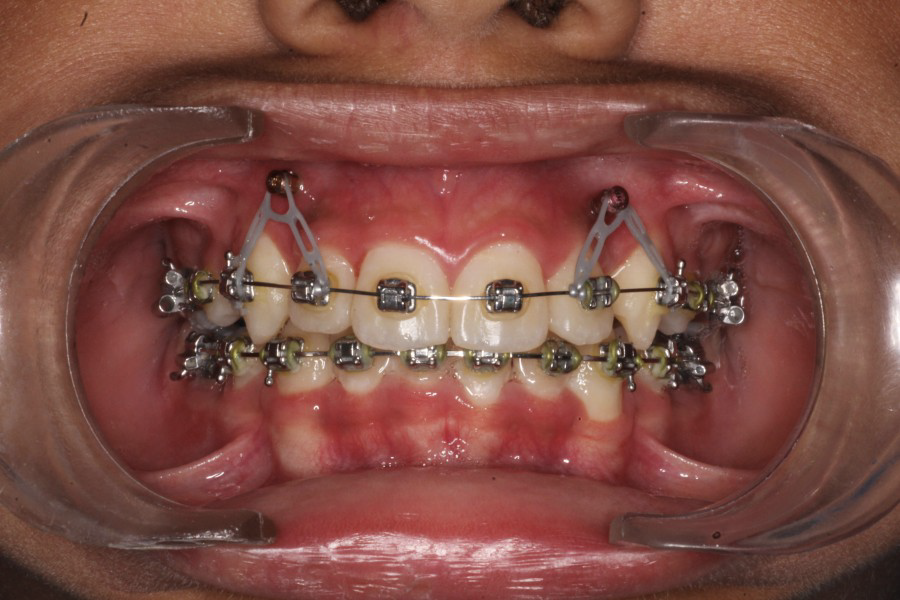Orthodontic tooth movement is often cited in orthodontic literature to be around 0.5 to 1.5 millimeters per month on average. The range is so broad because tooth movement is influenced by a plethora of factors.
Even with aligners, the story is the same. Clear aligners apply a more consistent force to the teeth, and the rate of movement varies but is typically estimated at 0.2 to 0.3 millimeters per aligner. Because patients change their aligners every 1-2 weeks, this equates to about 1 to 1.5 millimeters of movement per month.
Numerous variables affect the movement of orthodontic teeth, which can be divided into four major groups: patient-related variables, treatment-related variables, biological elements, and mechanical aspects. These factors interact and influence the efficiency and speed of orthodontic tooth movement. I’ll group and describe them in brief here:
Factors related to the patient affecting the rate of Orthodontic tooth movement:
- Age: Skeletal development has an impact on tooth movement. Due to their still-growing bones, adolescents typically experience faster tooth movement than adults.
- Genetics: A person’s bone density, the makeup of their gum tissue, and the way their teeth respond to orthodontic force are all influenced by genetic factors.
- Overall Health: Systemic issues and general well-being can influence how quickly teeth move. For instance, orthodontic treatment may be impacted by illnesses that affect bone metabolism.
- Oral habits: Practises like tongue thrusting, nail-biting, and mouth breathing can have an impact on how teeth move and how well treatments work.
Factors Related to Treatment affecting the rate of Orthodontic tooth movement:
- The type of orthodontic appliance used, such as conventional braces, clear aligners, or functional appliances, can affect the speed and course of tooth movement.
- The extent and duration of the forces used by orthodontists to move teeth. The strength, direction, and duration of these forces play a crucial role in determining how quickly and effectively teeth move.
- Biomechanics: Tooth movement may be impacted by the mechanical construction of orthodontic appliances, such as brackets, wires, and elastics.
- Treatment Planning: For orthodontic treatment to be successful, a well-organized treatment plan that takes the precise tooth movements required and their order into account is essential.
- Patient cooperation in wearing appliances as directed and adhering to oral hygiene instructions can have a big impact on how well treatments go.
- Successful tooth movement is dependent on the periodontal and gum tissues being in good health. Any form of gum disease or swelling can restrict tooth movement.
- Retention: Post-treatment stability and retention protocols are essential to keep the gains made and avoid relapse.
Biological Elements affecting the rate of Orthodontic tooth movement
- Bone Density: The amount and type of bone that surrounds teeth has an impact on how quickly and steadily they move.
- Healthy gums and periodontal tissues are necessary for a tooth to move effectively and steadily.
- Blood Supply: For bone remodeling and tissue reaction during tooth movement, a healthy blood supply is essential.
- Inflammation: Oral inflammation can prevent teeth from moving and raise the possibility of complications.
- Gingival biotype refers to the thickness and characteristics of the gum tissues around teeth. There are two main types: thin and thick. Thin gingival biotypes have thinner gum tissues, causing faster tooth movement but increasing the risk of recession. Thick gingival biotypes have dense and fibrous gum tissues, providing better support and reducing the risk of recession.
- Hormones: Changes in hormones, such as those that occur during pregnancy, can impact the mobility of teeth.
Mechanical aspects affecting the rate of Orthodontic tooth movement.
- Force Amount and Direction: The amount, type, and direction of orthodontic forces used to move teeth affect the speed and plane of movement.
- Application of Force for a Longer Period of Time: Longer and continuous force applications may cause teeth to move more noticeably.
- Type of Appliance: Various orthodontic appliances, such as braces and aligners, exert forces in a variety of ways that can affect the speed and type of tooth movement.
- Biomechanics: The stability and movement of teeth are influenced by the mechanical design of orthodontic appliances, such as brackets, wires, and attachments.
- Archwire Material: The type of archwire used (such as stainless steel or nickel-titanium) affects how effectively and precisely teeth move.
- Treatment Plan: For orthodontic treatment to be successful, a well-organized treatment plan that takes the desired tooth movements and their order into account is essential.
- Tooth Movement Rate: Too rapid movement can result in root resorption.
- Patient Compliance: For tooth movement to be successful, the patient’s cooperation in wearing the appliances as directed and adhering to oral hygiene instructions is crucial.
- Interference: Any obstructions or interferences that block the natural path of tooth movement may slow it down.
- Case Complexity: Complex cases may require more time and careful planning.
- Orthodontic Emergencies: Problems like breakages, debonding, and trauma during the procedure may cause the orthodontic tooth movement to take longer.
- Retention: For maintaining the achieved results and preventing relapse, post-treatment retention protocols, including the use of retainers, are essential.
The orthodontist’s experience and skill in planning and carrying out treatment have a significant impact on the success of tooth movement. An orthodontist must consider the aforementioned factors, as well as many others that I may have overlooked while writing this article, in order to provide our patients with the best results in the shortest amount of time.

